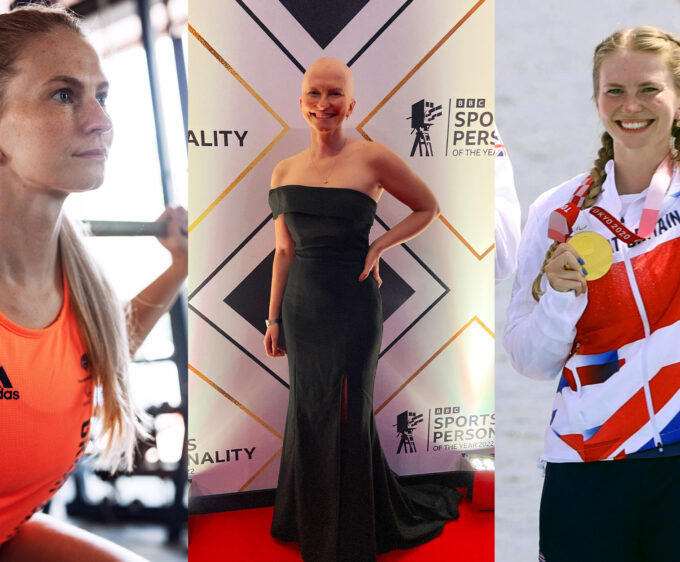
Period Power
“I can utilise the hormones that are working for me at the time.” Jessica Ennis-Hill and Dr Emma Ross on their period-planning app that helps you get the best out of every stage of your cycle
By Liz Connor
Illustration by Taylor McManus
When she was at the height of her Olympic career, Jessica Ennis-Hill was tracking every incremental metric that could give her a winning edge on the track, from sleep and hydration to nutrition and recovery. But her period? That was never talked about, let alone considered a major performance barrier for an elite athlete. It wasn’t until Jessica made her famous comeback in 2015 that the importance of hormones really hit home for the track and field legend. Just 15 months after giving birth to her son Reggie, she won the heptathlon world title in Beijing – her third world championship gold medal in a row. Then, at the Rio Olympics the following summer, she went on to secure a silver medal.

The Missing Link
“When my son was born, it was the first time that my team [which included a coach, physiotherapist, nutritionist and biomechanic] had to seek information about the menstrual cycle. At the time, it felt like there was nothing readily available to help practitioners treat their athletes’ bodies coming back into elite sport.” Looking back to her Olympic training in 2012, Jessica says that there was “definitely a knowledge gap” when it came to understanding the physiological differences between men and women. “It’s something that, in hindsight, really shocks me, because when you’re an athlete every element of your training is analysed and [you and your team] are constantly trying to find all those tiny advantages. “The menstrual cycle felt like a really uncomfortable thing to even, like, bring up at training,” she admits. “At certain phases, I knew I felt more productive, and then at others, I’d feel lethargic; like I didn’t have the energy levels that I’d normally have.” Despite intuitively feeling below par, she’d gird against her body and “push on” through the symptoms.

Encouraged by the difference she felt while training with her hormones in mind, Jessica was inspired to create Jennis (jennis.com) – a ‘cycle mapping’ app that creates a unique fitness plan for women based on the various phases of their period. Designed to be a period tracker-meets-fitness coach, it makes data-driven recommendations that aim to avoid exacerbating painful PMS symptoms. Cycle mapping has been a game changer in women’s football and rugby in recent years; many teams, such as Chelsea FC Women, have pivoted to training around in sync with their player’s periods.
“Generally speaking, cycle mapping is a way of helping women to understand their experience of their menstrual cycle, empowering them with the knowledge about what that physiology means to them, in terms of which exercises might feel better and what what their body is geared up to do at certain times of the cycle,” explains Jennis physiologist Dr Emma Ross, who co-founded the app with Jessica. The two friends first met when Jessica was still a competitive athlete and Emma was working for the English Institute of Sport in the run-up to the Rio Olympics.
“Across the four different phases of your menstrual cycle, there are a lot of powerful hormonal changes that take place,” explains Emma. “Oestrogen rises in your body during your follicular phase, so your muscles adapt better, recover better and fatigue less, which makes it a great time to push your workouts and chase a PB.”

Progesterone levels, meanwhile, spike across your luteal phase. Your metabolism switches to preferring fat as your main source of fuel and this makes it a great time for longer, steady state endurance sessions. During the period and pre-menstrual phases though, you’re most likely to experience symptoms like headaches, anxiety, irritation, low mood and abdominal cramps, which is why it’s important to slow down and rest. The app takes all this health data into account when it’s designing workout plans. When you sign up, you go through a quick questionnaire that helps the algorithm understand your fitness goals and level, cycle length and typical monthly symptoms. From here, Jennis identifies where you are in your cycle and makes smart recommendations based on the hormone profile of the phase that you’re in. Each day, you’re recommended a different selection of 5 to 35 minute workouts, the idea being that you take your all-out HIIT sessions in your follicular phase, where you’re most likely to feel most energised, but schedule recovery yoga during your period phase, where you’re juggling symptoms.
Permission To Rest
Aside from reducing premenstrual aches and pains, there are plenty of other benefits to training in this way. A recent study found that you can build up to 15% more lean muscle if you stack your strength training in the first half of your cycle. Essentially you work smarter, not harder, and achieve better results. Emma says that preliminary studies from Jennis show that women who have permission to rest during their period and pre-menstrual phases have increased motivation towards exercise too, as well as better mood overall. “Psychologically, it feels better to work out in this way. And it kind of relates to that idea of giving yourself permission. So instead of feeling like you’re failing because you’re not going all out on any given day, you feel empowered to rest and take things down a notch when you need to.”

Empowered
Right now, we’re just touching the surface of what period-driven workouts can do for women. Overwhelmingly, there is a gender data gap in sport’s science. Much of the scientific data collected in sport focuses on men and recently it was revealed that only 6% of spotlight sports science studies were made exclusively on women in the past five years. In lieu of this data, part of Jennis’ mission is to make every woman body literate.
The Gender Data Gap
In a nutshell, Emma says the term means understanding how our body feels and then having the knowledge to act on what it’s telling us. “For a long time in sport and exercise, whether at grassroots or elite level, we haven’t taken a female-centric approach to training or nutrition. This is because we’ve all assumed that what works for one group of people is going to work for all. “Much of the scientific research has not been conducted on women, so we’ve overlooked the fact that it’s actually really important to consider the menstrual cycle and hormones when we’re designing, training and thinking about getting fitter.”
Body literacy is focused on not just observing, but learning and understanding too. Emma believes that it urgently needs to be added to the school curriculum, not just to help girls better understand their periods, but to also eliminate embarrassment and shame around menstrual bleeding. “PSHE education has improved, but teens in schools are generally taught about the mechanics of periods. While this information is useful, we fail to relate the biology to how we feel physically and emotionally, and how we can best deal with some of the challenging parts of the hormonal cycle.”
She’s frustrated that we also don’t spotlight the good parts too. “Oestrogen can make us feel amazing; progesterone can make us feel calmer, and we don’t sell the cycle as a really brilliant, positive thing that’s happening in a girl’s body. We have a generation of women who are going through menopause who have suddenly realised so much about their bodies they didn’t understand; the role of hormones in our health and how we feel. If we open up that conversation early, there is no shame or stigma around any of this stuff.”

Encouragingly, the app has been helping women to utilise hormone spikes to their advantage. Juli, 43, a caterer from Glasgow has been using Jennis for nine months and has noticed the positive difference the training has made on her physical and mental wellbeing. “I’ve become stronger, leaner and fitter. What’s really great though is that my running times have improved and I’ve achieved some personal bests by training at stages in my cycle where I can utilise the hormones that are working for me at the time. “It’s been great for my mental health too. I’m actually working out more, as on days where I might feel like doing nothing there are gentle yoga or stretches to keep your body moving. I have a young daughter and when the time comes, I will definitely have open and honest conversation with her about her periods, her cycle and how to benefit from it, instead of seeing it as something that can set you back once a month.

“I don’t think I was conscious of my cycle before – I’d never considered how it could be affecting me other than when I was on my period and I didn’t feel like exercising,” adds Kirsty, 34, who works in communications and discovered Jennis after following Jessica on Instagram. “It’s been really fascinating to understand the role of hormones. This isn’t ever something that I learnt growing up and it’s taken until my 30s to discover the benefits of tracking my cycle and using my hormones to my advantage. It’s really changed how I think about fitness and my body.”
Finding the sweet spot between results and enjoyment is so important to Jessica and Emma, who have both seen the negative effects of overtraining and burnout. Rather than staying silent and pushing through the pain, they want women to embrace their cycle as a superpower that can help them to gain the competitive edge. “In sport, a lot of coaches, practitioners and support staff are men, so it creates a layer of feeling uncomfortable when talking about periods, as lots of men don’t fully understand it,” says Jessica. “It’s so common to feel like you don’t want to look like you’re weak and you can’t do something, so you just don’t say anything and overtrain. We really want to change that. If you focus on the benefits and the way you can harness your individual menstrual cycle, then it can be so impactful.” “The menstrual cycle is seen as a negative – but why? Let’s look at the positives and how women can use it to their advantage.”




